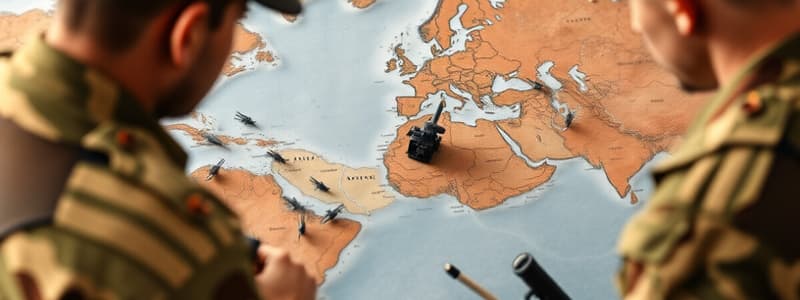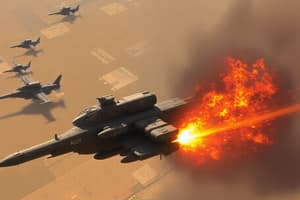Podcast
Questions and Answers
Which of the following best describes the 'three-legged stool' analogy in relation to national security?
Which of the following best describes the 'three-legged stool' analogy in relation to national security?
- It illustrates the relationship between national policy, military alliances, and technological advancements.
- It refers to the balance between military objectives, economic power, and diplomatic strategies.
- It highlights the importance of military objectives, strategic concepts, and resources. (correct)
- It emphasizes the need for military technology, training, and intelligence.
What role does risk play in military strategy according to the content?
What role does risk play in military strategy according to the content?
- Risk only pertains to financial investments in military operations.
- Risk represents the certainty of achieving objectives without fail.
- Risk is the possibility of loss or not achieving an objective. (correct)
- Risk is irrelevant as long as military resources are adequate.
Which combination is critical for ensuring national security according to the analogy?
Which combination is critical for ensuring national security according to the analogy?
- The balance between military objectives and international treaties.
- Military resources must be compatible with strategic concepts. (correct)
- Force structure must prioritize global diplomatic relations.
- Military capabilities should overshadow strategic concepts.
What does military force structure depend upon?
What does military force structure depend upon?
How can the concept of tilt be interpreted in the context of military strategy?
How can the concept of tilt be interpreted in the context of military strategy?
Which of the following is NOT mentioned as a traditional military strategy?
Which of the following is NOT mentioned as a traditional military strategy?
What must be matched to ensure effective military commitments?
What must be matched to ensure effective military commitments?
Which key aspect influences both military objectives and strategic concepts?
Which key aspect influences both military objectives and strategic concepts?
What is primarily involved in the establishment of military strategy?
What is primarily involved in the establishment of military strategy?
Which strategy is indicated by a shift in military force structure due to changing objectives?
Which strategy is indicated by a shift in military force structure due to changing objectives?
How does the flexibility of military strategy impact force structure?
How does the flexibility of military strategy impact force structure?
What does a misplaced military strategic concept threaten?
What does a misplaced military strategic concept threaten?
What challenge may arise when military force is employed in pursuit of national policy objectives?
What challenge may arise when military force is employed in pursuit of national policy objectives?
Which administration is associated with the 2 1/2-war strategy?
Which administration is associated with the 2 1/2-war strategy?
The term 'Realistic Deterrence' is best related to which aspect of military strategy?
The term 'Realistic Deterrence' is best related to which aspect of military strategy?
Which of the following best defines a military strategic concept?
Which of the following best defines a military strategic concept?
In risk management, military commanders should focus on which of the following aspects?
In risk management, military commanders should focus on which of the following aspects?
Which of the following is NOT a key component of military strategy?
Which of the following is NOT a key component of military strategy?
Which strategy involves the use of military options in conjunction with allies?
Which strategy involves the use of military options in conjunction with allies?
What is a significant risk factor when military strategies conflict with one another?
What is a significant risk factor when military strategies conflict with one another?
What are strategic reserves primarily intended for?
What are strategic reserves primarily intended for?
What key distinction must be understood between military and political objectives?
What key distinction must be understood between military and political objectives?
What can be a consequence of employing military force without proper situational assessment?
What can be a consequence of employing military force without proper situational assessment?
Which of these elements is NOT typically part of military strategic concepts?
Which of these elements is NOT typically part of military strategic concepts?
Flashcards are hidden until you start studying
Study Notes
Military Strategy Analogy
- Military strategy is often metaphorically represented by a three-legged stool where each of the three legs symbolizes essential components: "Objectives," "Concepts," and "Resources." This analogy emphasizes the interdependence of these elements in achieving a cohesive and effective military strategy.
- For effective military operations, it is imperative that these legs be balanced. An imbalance in any area can lead to significant vulnerabilities and ultimately jeopardize national security. For instance, an over-emphasis on resources without aligning strategic concepts may result in a lack of direction in military engagements.
- Imbalances between military resources, strategic concepts, and commitments not only create operational challenges but can also erode public trust and undermine strategic credibility. When military resources are misallocated or strategic concepts are poorly defined, the military risks compromising its ability to address threats effectively.
Risk
- Risk, in this context, is defined as the potential for loss, damage, or the inability to achieve defined objectives. Every military initiative carries inherent risks, and assessing these risks is critical to formulating successful strategies. Learning to identify and mitigate risks involves understanding the full spectrum of potential threats and operational challenges.
Objectives
- Establishing clear military objectives is fundamental to the development of effective strategic concepts and the organization of force structure and global deployments. Military objectives serve as the guiding star of military operations, shaping how resources are allocated and how troops are deployed across theaters of war.
- National policies significantly influence military objectives. Political leadership plays an essential role in articulating the goals of military engagements, which, in turn, can be shaped by factors such as diplomacy, public opinion, and international relations.
- Objectives may sometimes lean toward political or economic considerations, complicating the process of formulating military objectives. The challenge arises when political leaders prioritize short-term gains over long-term strategic needs, potentially resulting in military overreach or insufficient resource allocation.
Strategic Concepts
- Strategic concepts are essentially blueprints that are derived from a comprehensive assessment of the strategic situation within a given context. These concepts outline how military power should be employed to meet the established objectives effectively.
- There are multiple options for strategic concepts, which include: forward defense (where forces are positioned to deter aggression before it occurs), strategic reserves (forces held back for use in emergencies), reinforcements (additional troops sent to an area in response to escalating threats), show of force (demonstrations of military capabilities to deter adversaries), pre-positioned stocks (military supplies and equipment located in strategic areas), collective security (alliances that enhance security), and security assistance (supporting allied nations' military capabilities).
- Strategic concepts are not static; they must evolve in response to changing geopolitical dynamics, technological advancements, and the emergence of new threats. Active monitoring of the strategic landscape is necessary to adapt these concepts quickly and effectively. The ability to pivot and respond to new intelligence can mean the difference between success and failure in military operations.
Resources
- Resources, encompassing financial allocations, technology acquisitions, and personnel management, are critical components that underpin military strategy. As strategic goals evolve, procurement guidelines may need to be updated to reflect the new priorities and capabilities required.
- It's vital to ensure that military resources are synergistically aligned with both strategic concepts and objectives. This alignment helps prevent wastage of resources, maximizes operational effectiveness, and fosters the development of a cohesive military strategy that can meet the demands of modern warfare.
Examples of Military Strategic Concepts
- Various military strategies are employed, encompassing concepts such as attrition (wearing down the enemy), annihilation (total destruction of enemy forces), countervalue (targeting enemy infrastructure), counterforce (targeting military forces directly), warfighting (actively engaging in combat), direct and indirect approaches (varying styles of engagement), search and destroy (hunting enemy capabilities), oil spot (spreading military influence), assured destruction (second-strike capabilities), containment (preventing the spread of adversarial influence), and countervailing strategies (countering threats with equivalent responses).
- Strategic doctrines also provide frameworks for military response, such as the Carter Doctrine, which emphasizes the use of military force in the Persian Gulf; "Flexible Response," which allows for a range of responses to aggression; "Realistic Deterrence," focusing on credible deterrent strategies; the "2 1/2-war strategy," which promotes preparation for two major regional conflicts and a smaller one simultaneously; and the "1 1/2-war strategy," which scales down those preparations.
Summary
- The essence of military strategy lies in the careful establishment of military objectives, the thoughtful formulation of strategic concepts intended to fulfill those objectives, and the prudent utilization of resources to effectively implement these strategies. This triad ensures that military forces are capable of responding to various threats and that national security interests are robustly defended.
- National security remains at risk when any elements of military strategy are misaligned or incompatible with one another. Such discrepancies can lead to ineffective planning, operational failures, and ultimately endanger the safety of the nation and its allies.
Studying That Suits You
Use AI to generate personalized quizzes and flashcards to suit your learning preferences.




